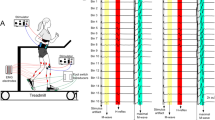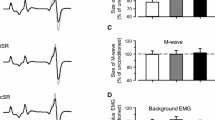Summary
In eight normal subjects, the excitability of the soleus (Sol) H-reflex was tested in parallel with Sol length changes, EMGs of leg and thigh muscles and ground contact phases, during three different pacing movements: bipedal treadmill walking, single limb treadmill walking, and single-limb stepping on one spot. A computerized procedure was used which compensated for changes in stimulus effectiveness that occurred during free motion. In the three paradigms examined, significant excitability modulations were observed with respect to a control level determined in standing weight-bearing position. During bipedal treadmill walking, excitability was decreased in the early stance, maximally enhanced in the second half of the stance, and again decreased during the end-stance and the whole swing phase, with a minimum value around the toe off period. The main modulation pattern was retained during single-limb treadmill walking. During single-limb stepping on one spot, the stance-phase increase in excitability and the swing phase depression were still present. However, in the second half of the swing phase, reflex responsiveness returned to reference level, which was maintained during the subsequent contact period. Moreover, a decrease in reflex excitability was detected around the mid-stance. The time course of the described modulations was only partly correlated with the EMG and length changes of the Sol muscle. Furthermore, in the three movements tested, during the early stance phase, the excitability of the H-reflex arc did not correspond to the one expected on the basis of the available H-reflex studies performed under static conditions. It is suggested that, at least in certain stride phases (e.g. around the early contact period), an active regulation affects the transmission in the Sol myotatic arc during the pacing movements investigated.
Similar content being viewed by others
References
Akazawa K, Aldridge JW, Steeves JD, Stein RB (1982) Modulation of stretch reflexes during locomotion in the mesencephalic cat. J Physiol (Lond) 329: 553–567
Andersson O, Forssberg H, Grillner S, Lindquist M (1978) Phasic gain control of the transmission in cutaneous reflex pathways to motoneurons during “fictive” locomotion. Brain Res 149: 503–507
Basmajian JV (1967) Muscles alive. Williams and Wilkins, Baltimore
Bayev KB (1978) Periodic changes of primary afferent depolarization during fictitious locomotion by thalamic cats. Neurophysiology 10: 316–317
Bayev KV, Kostyuk PG (1982) Polarization of primary afferent terminals of lumbosacral cord elicited by the activity of spinal locomotor generator. Neuroscience 7: 1401–1409
Belanger M, Patla AE (1984) Corrective responses to perturbation applied during walking in humans. Neurosci Lett 49: 291–295
Berger W, Dietz V, Quintern J (1984) Corrective reactions to stumbling in man: neuronal coordination of bilateral leg muscle activity during gait. J Physiol (Lond) 357: 109–125
Conrad B, Klingelhofer J, Bertram G, Meinck HM (1985) Gating of reflexes in leg muscles during hopping. Neurosci Lett 22: S126
Conrad B, Benecke R, Carnehl J, Hohne J, Meinck HM (1983) Pathophysiological aspects of human locomotion. In: Desmedt JE (ed) Motor control mechanisms in health and disease. Adv in Neurol 39: 699–716
Crenna P, Frigo C (1983) Walking perturbations produced by cutaneous stimulation in man. Proc IFAC Workshop on Human Gait Analysis and Application, INSERM, pp 217–225
Crenna P, Frigo C (1984) Evidence of phase — dependent nociceptive reflexes during locomotion in man. Exp Neurol 85: 336–345
Crenna P, Frigo C (1985a) Monitoring gait by a vector diagram technique in spastic patients. In: Delwaide PJ, Young RR (eds) Clinical neurophysiology in spasticity. Elsevier, Amsterdam, pp 109–124
Crenna P, Frigo C (1985b) Hindered muscle relaxation in spasticity: experimental evidence suggesting a possible pathophysiological mechanism. Ital J Neurol Sci 6: 481–489
Delwaide PJ (1973) Human monosynaptic reflexes and presynaptic inhibition. In: Desmedt JE (ed) New developments in electromyography and clinical neurophysiology. Karger, Basel, pp 508–522
Dietz V, Noth J (1978) Spinal stretch reflexes of triceps surae in active and passive movements. J Physiol (Lond) 284: 180–181
Dietz V, Schmidtbleicher D, Noth J (1979) Neuronal mechanisms of human locomotion. J Neurophysiol 42: 1212–1222
Dietz V, Quintern J, Berger W (1985) Afferent control of human stance and gait: evidence for blocking of group I afferents during gait. Exp Brain Res 61: 153–163
Dubuc R, Cabelguen JM, Rossignol S (1985) Rhythmic antidromic discharges of single primary afferents recorded in cut dorsal root filaments during locomotion in the cat. Brain Res 359: 375–378
Duysens J, Pearson KJ (1976) The role of cutaneous afferents from the distal hind limb in the regulation of the step cycle of thalamic cats. Exp Brain Res 24: 245–255
Edgerton VR, Grillner S, Sjostrom A, Zangger P (1976) Central generation of locomotion in vertebrates. In: Herman S, Grillner S, Stein P, Stuart DG (eds) Neural control of locomotion. Plenum Press, New York, pp 439–464
Feldman AG, Orlovski GN (1975) Activity of interneurons mediating reciprocal Ia inhibition during locomotion. Brain Res 94: 181–194
Ferrigno G, Pedotti A (1985) Elite: a digital dedicated hardware system for movement analysis via real-time TV-signal processing. IEEE Trans BME 32: 943–950
Frigo C, Pedotti A (1978) Determination of muscle length during locomotion. In: Asmussen E, Jorjensen K (eds) Biomechanic VI. University Park Press, Baltimore, pp 355–360
Garrett M, Ireland A, Luckwill RG (1984) Changes in excitability of the Hoffmann reflex during walking in man. J Physiol (Lond) 355: 23P
Garrett M, Luckwill RG (1983) Role of reflex responses of knee musculature during the swing phase of walking in man. Eur J Appl Physiol 52: 36–41
Gottlieb GL, Agarwal GC, Stark L (1970) Interaction between voluntary and postural mechanisms of the human motor system. J Neurophysiol 33: 365–381
Gottlieb GL, Agarwal GC (1973) Modulation of postural reflexes by voluntary movement. I. Modulation of the active limb. J Neurol Neurosurg Psychiat 36: 529–539
Gottlieb GL, Agarwal GC (1979) Response to sudden torques about ankle in man: myotatic reflex. J Neurophysiol 42: 91–106
Greenwood R, Hopkins A (1976) Landing from an unexpected fall and a voluntary step. Brain 99: 375–386
Grillner S (1981) Control of locomotion in bipeds, tetrapodes and fish. In: Brooks VE (ed) Handbook of physiology. The nervous system, Vol II. Am Physiol Soc, Bethesda, pp 1179–1236
Grillner S (1985) Neurobiological bases of rhythmic motor acts in vertrebrates. Science 228: 143–149
Hongo T, Lundberg A, Phillips, Thompson RF (1984) The patterns of monosynaptic Ia connections to hindlimb motor nuclei in the baboon: a comparison with the cat. Proc R Soc Lond B 221: 261–289
Hugon M (1973) Methodology of the Hoffmann reflex in man. In: Desmedt JE (ed) New developments in electromyography and clinical neurophysiology. Karger, Basel, pp 277–293
Iles JF (1986) Reciprocal inhibition during agonist and antagonist contraction. Exp Brain Res 62: 212–214
Kanda K, Sato H (1983) Reflex responses of human thigh muscles to non-noxious sural stimulation during stepping. Brain Res 288: 378–380
Kearney RE, Hunter IW (1983) System identification of human triceps surae stretch reflex dynamics. Exp Brain Res 51: 117–127
Knutsson E (1985) Studies of gait control in patients with spastic paresis. In: Delwaide PJ, Young RR (eds) Clinical neurophysiology in spasticity. Elsevier, Amsterdam, pp 175–183
Kots YM (1977) The organization of voluntary movement. Neurophysiological mechanisms. Plenum Press, New York London
Lennard PR, Hermanson JW (1985) Central reflex modulation during locomotion. Trends Neurosci 8: 483–486
Loeb GE (1981) Somatosensory unit input to the spinal cord during normal walking. Can J Physiol Pharmacol 59: 627–635
Meinck HM (1980) Facilitation and inhibition of the human H-reflex as a function of the amplitude of the control reflex. Electroenceph Clin Neurophysiol 48: 203–211
Melvill Johnes G, Watt DGD (1971) Observations on the control of stepping and hopping movements in man. J Physiol (Lond) 219: 709–727
Morin C, Katz R, Mazieres L, Pierrot-Deseilligny E (1982) Comparison of soleus H-reflex facilitation at the onset of soleus contractions produced voluntarily and during the stance phase of human gait. Neurosci Lett 33: 47–53
Murray MP, Spurr GB, Sepic SB, Gardner GM, Mollinger LA (1985) Treadmill vs. floor walking: kinematics, electromyogram and heart rate. J Appl Physiol 6: 87–91
Paillard J (1955) Reflexes et regulations d'origine proprioceptive chez l'homme. Etude neurophysiologique et psychophysiologique, Arnette, Paris
Pearson KG, Duysens J (1976) Function of sequential reflexes in the control of stepping in cockroaches and cats. In: Herman RM, Grillner S, Stein P, Stuart DG (eds) Neural control of locomotion. Plenum Press, New York, pp 519–538
Pierrot-Deseilligny E, Bergego C, Mazieres L (1983) Reflex control of bipedal gait in man. In: Desmedt JE (ed) Motor control mechanisms in health and disease. Raven Press, New York, pp 699–716
Pierrot-Deseilligny E, Mazieres L (1985) Spinal mechanisms underlying spasticity. In: Delwaide PJ, Young RR (eds) Clinical neurophysiology in spasticity. Elsevier Amsterdam, pp 63–73
Plas, F, Viel E, Blanc Y (1959) La marche humaine. Masson, Paris
Schieppati M, Crenna P (1984a) Natural cutaneous stimulation induces late and long lasting facilitation of extensor moto-neurones in the cat. Brain Res 293: 259–267
Schieppati M, Crenna P (1984b) From activity to rest: gating of excitatory autogenetic afferences from the relaxing muscle in man. Exp Brain Res 56: 448–455
Schieppati M, Crenna P (1985) Excitability of reciprocal and recurrent inhibitory pathways after voluntary muscle relaxation in man. Exp Brain Res 59: 249–256
Shindo M, Harayama M, Kondo K, Yanagisawa N, Tanaka R (1984) Changes in reciprocal Ia inhibition during voluntary contraction in man. Exp Brain Res 53: 400–408
Shomburg ED, Behrends HB (1978) The possibility of phase-dependent monosynaptic and polysynaptic Ia excitation to homonimous motoneurons during fictive locomotion. Brain Res 143: 533–537
Taylor J, Stein RB, Murphy PR (1985) Impulse rates and sensitivity to stretch of soleus muscle spindle afferent fibers during locomotion in premammillary cats. J Neurophysiol 53: 341–360
Author information
Authors and Affiliations
Rights and permissions
About this article
Cite this article
Crenna, P., Frigo, C. Excitability of the soleus H-reflex arc during walking and stepping in man. Exp Brain Res 66, 49–60 (1987). https://doi.org/10.1007/BF00236201
Received:
Accepted:
Issue Date:
DOI: https://doi.org/10.1007/BF00236201




